University Law Report: Contract and Negligence Legal Analysis
VerifiedAdded on 2019/12/03
|13
|4258
|60
Report
AI Summary
This report provides a comprehensive analysis of the legal aspects of contract and negligence. It begins by outlining the essential elements required for a valid contract, including offer, acceptance, intention of legal consequence, and consideration. Different types of contracts, such as verbal, written, bilateral, unilateral, face-to-face, and distant contracts, are discussed, along with their impacts. The report then examines contract terms, including conditions, warranties, and innominate terms, and their effects. Case scenarios illustrate the application of contract law, including offer and acceptance, and the impact of breach of contract. The report further contrasts tort liability with contractual liability, explaining the nature of negligence and vicarious liability in business. Elements of the tort of negligence and vicarious liability are also explained. Finally, the report provides a conclusion and references.
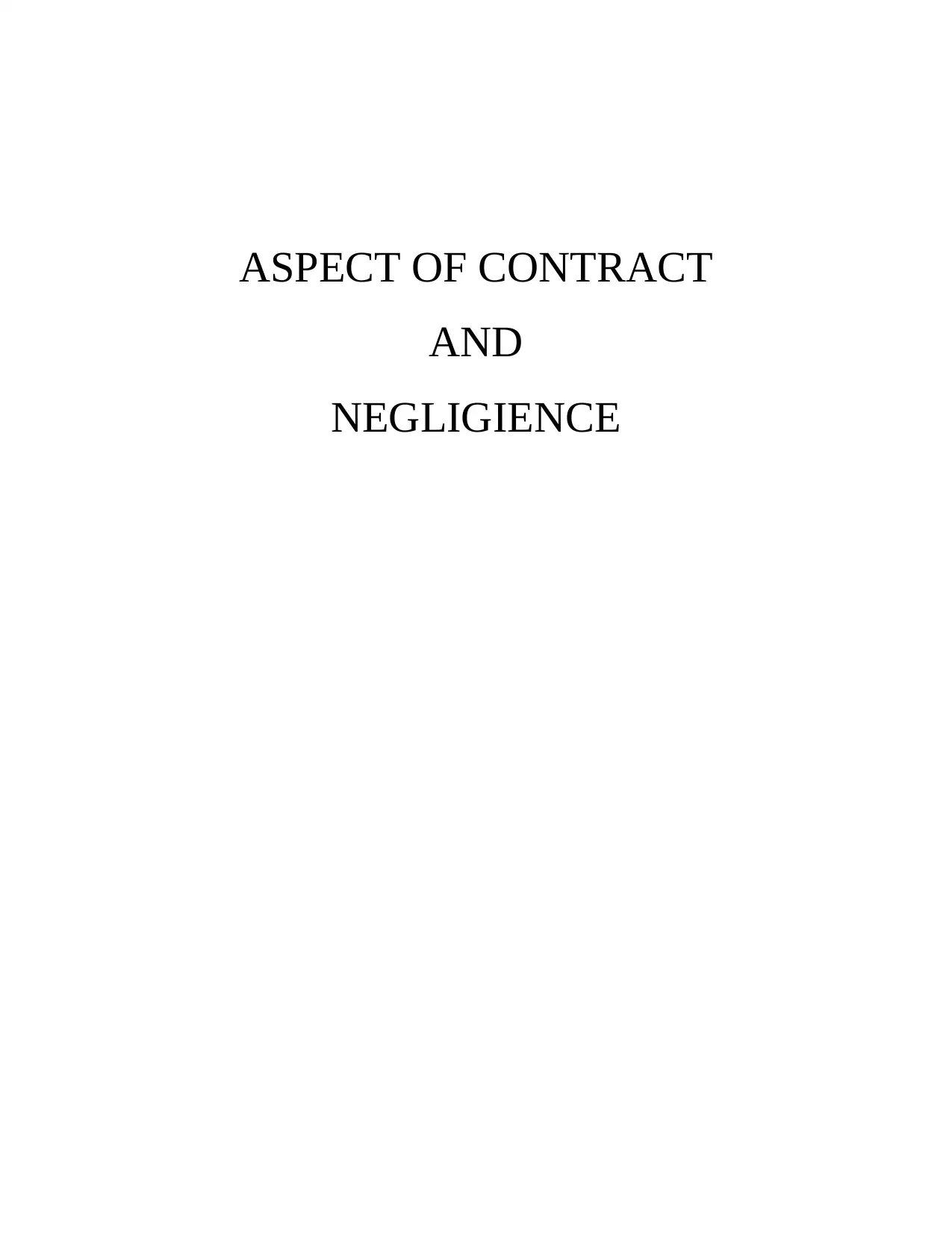
ASPECT OF CONTRACT
AND
NEGLIGIENCE
AND
NEGLIGIENCE
Paraphrase This Document
Need a fresh take? Get an instant paraphrase of this document with our AI Paraphraser
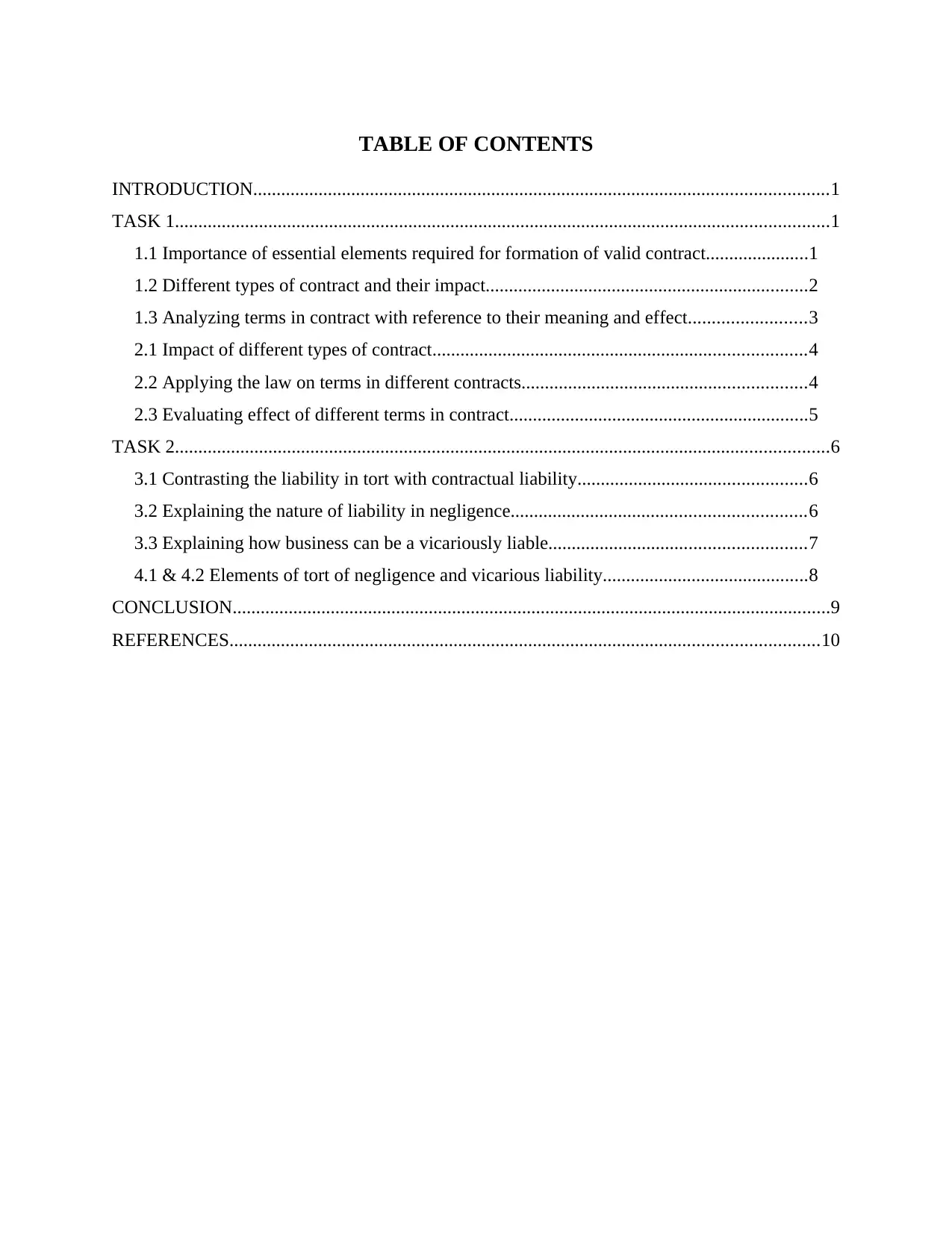
TABLE OF CONTENTS
INTRODUCTION...........................................................................................................................1
TASK 1............................................................................................................................................1
1.1 Importance of essential elements required for formation of valid contract......................1
1.2 Different types of contract and their impact.....................................................................2
1.3 Analyzing terms in contract with reference to their meaning and effect.........................3
2.1 Impact of different types of contract................................................................................4
2.2 Applying the law on terms in different contracts.............................................................4
2.3 Evaluating effect of different terms in contract................................................................5
TASK 2............................................................................................................................................6
3.1 Contrasting the liability in tort with contractual liability.................................................6
3.2 Explaining the nature of liability in negligence...............................................................6
3.3 Explaining how business can be a vicariously liable.......................................................7
4.1 & 4.2 Elements of tort of negligence and vicarious liability............................................8
CONCLUSION................................................................................................................................9
REFERENCES..............................................................................................................................10
INTRODUCTION...........................................................................................................................1
TASK 1............................................................................................................................................1
1.1 Importance of essential elements required for formation of valid contract......................1
1.2 Different types of contract and their impact.....................................................................2
1.3 Analyzing terms in contract with reference to their meaning and effect.........................3
2.1 Impact of different types of contract................................................................................4
2.2 Applying the law on terms in different contracts.............................................................4
2.3 Evaluating effect of different terms in contract................................................................5
TASK 2............................................................................................................................................6
3.1 Contrasting the liability in tort with contractual liability.................................................6
3.2 Explaining the nature of liability in negligence...............................................................6
3.3 Explaining how business can be a vicariously liable.......................................................7
4.1 & 4.2 Elements of tort of negligence and vicarious liability............................................8
CONCLUSION................................................................................................................................9
REFERENCES..............................................................................................................................10
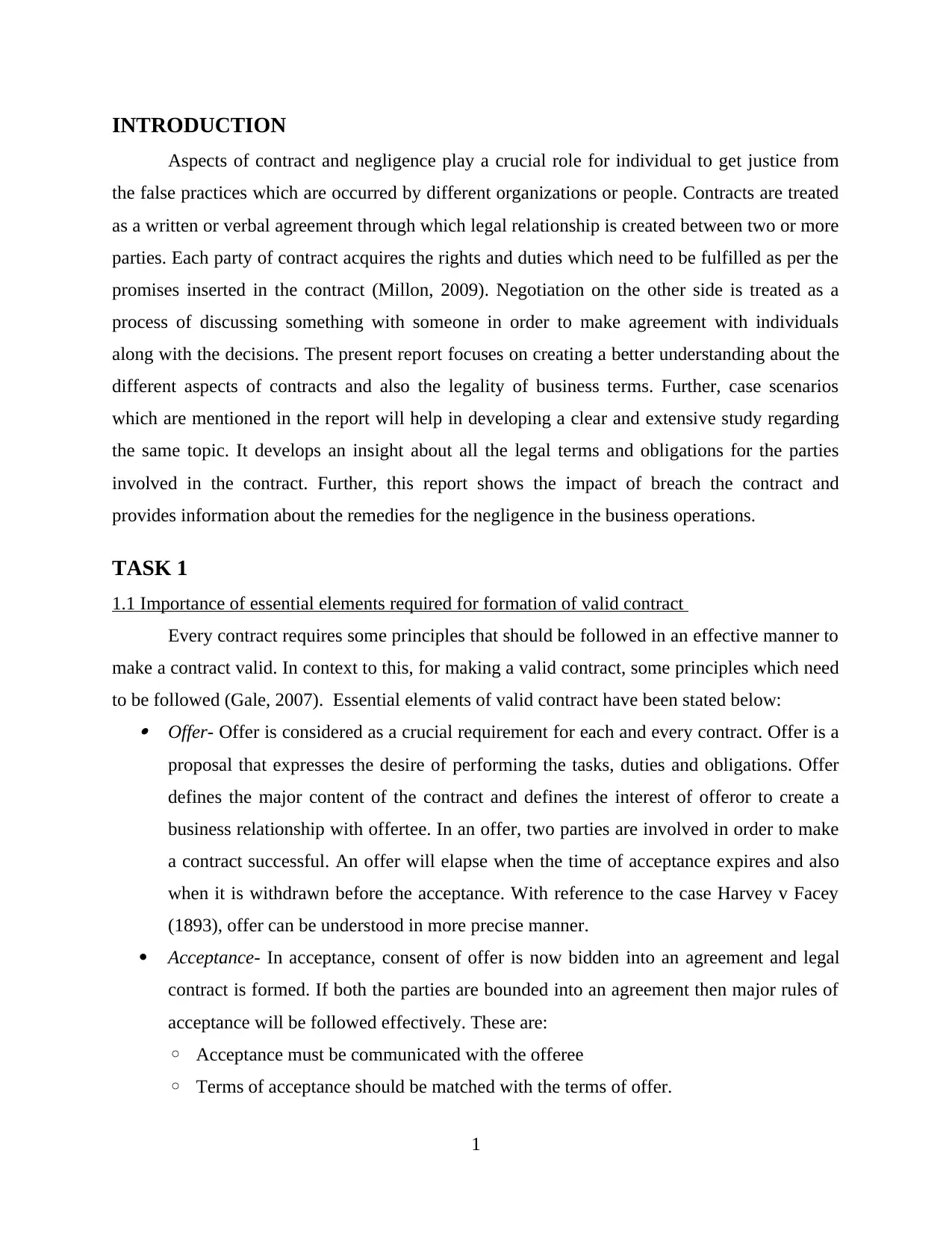
INTRODUCTION
Aspects of contract and negligence play a crucial role for individual to get justice from
the false practices which are occurred by different organizations or people. Contracts are treated
as a written or verbal agreement through which legal relationship is created between two or more
parties. Each party of contract acquires the rights and duties which need to be fulfilled as per the
promises inserted in the contract (Millon, 2009). Negotiation on the other side is treated as a
process of discussing something with someone in order to make agreement with individuals
along with the decisions. The present report focuses on creating a better understanding about the
different aspects of contracts and also the legality of business terms. Further, case scenarios
which are mentioned in the report will help in developing a clear and extensive study regarding
the same topic. It develops an insight about all the legal terms and obligations for the parties
involved in the contract. Further, this report shows the impact of breach the contract and
provides information about the remedies for the negligence in the business operations.
TASK 1
1.1 Importance of essential elements required for formation of valid contract
Every contract requires some principles that should be followed in an effective manner to
make a contract valid. In context to this, for making a valid contract, some principles which need
to be followed (Gale, 2007). Essential elements of valid contract have been stated below: Offer- Offer is considered as a crucial requirement for each and every contract. Offer is a
proposal that expresses the desire of performing the tasks, duties and obligations. Offer
defines the major content of the contract and defines the interest of offeror to create a
business relationship with offertee. In an offer, two parties are involved in order to make
a contract successful. An offer will elapse when the time of acceptance expires and also
when it is withdrawn before the acceptance. With reference to the case Harvey v Facey
(1893), offer can be understood in more precise manner.
Acceptance- In acceptance, consent of offer is now bidden into an agreement and legal
contract is formed. If both the parties are bounded into an agreement then major rules of
acceptance will be followed effectively. These are:
◦ Acceptance must be communicated with the offeree
◦ Terms of acceptance should be matched with the terms of offer.
1
Aspects of contract and negligence play a crucial role for individual to get justice from
the false practices which are occurred by different organizations or people. Contracts are treated
as a written or verbal agreement through which legal relationship is created between two or more
parties. Each party of contract acquires the rights and duties which need to be fulfilled as per the
promises inserted in the contract (Millon, 2009). Negotiation on the other side is treated as a
process of discussing something with someone in order to make agreement with individuals
along with the decisions. The present report focuses on creating a better understanding about the
different aspects of contracts and also the legality of business terms. Further, case scenarios
which are mentioned in the report will help in developing a clear and extensive study regarding
the same topic. It develops an insight about all the legal terms and obligations for the parties
involved in the contract. Further, this report shows the impact of breach the contract and
provides information about the remedies for the negligence in the business operations.
TASK 1
1.1 Importance of essential elements required for formation of valid contract
Every contract requires some principles that should be followed in an effective manner to
make a contract valid. In context to this, for making a valid contract, some principles which need
to be followed (Gale, 2007). Essential elements of valid contract have been stated below: Offer- Offer is considered as a crucial requirement for each and every contract. Offer is a
proposal that expresses the desire of performing the tasks, duties and obligations. Offer
defines the major content of the contract and defines the interest of offeror to create a
business relationship with offertee. In an offer, two parties are involved in order to make
a contract successful. An offer will elapse when the time of acceptance expires and also
when it is withdrawn before the acceptance. With reference to the case Harvey v Facey
(1893), offer can be understood in more precise manner.
Acceptance- In acceptance, consent of offer is now bidden into an agreement and legal
contract is formed. If both the parties are bounded into an agreement then major rules of
acceptance will be followed effectively. These are:
◦ Acceptance must be communicated with the offeree
◦ Terms of acceptance should be matched with the terms of offer.
1
⊘ This is a preview!⊘
Do you want full access?
Subscribe today to unlock all pages.

Trusted by 1+ million students worldwide
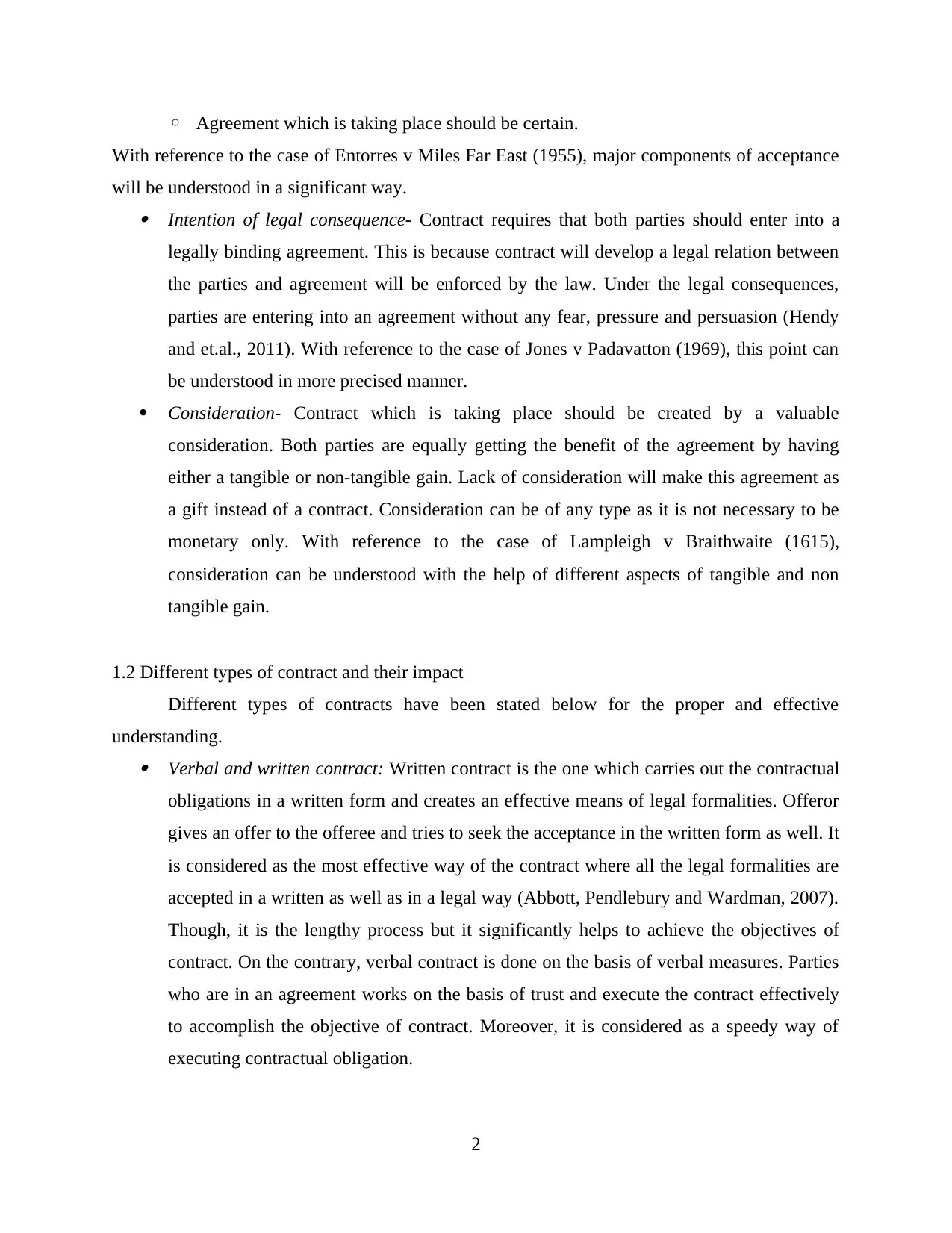
◦ Agreement which is taking place should be certain.
With reference to the case of Entorres v Miles Far East (1955), major components of acceptance
will be understood in a significant way. Intention of legal consequence- Contract requires that both parties should enter into a
legally binding agreement. This is because contract will develop a legal relation between
the parties and agreement will be enforced by the law. Under the legal consequences,
parties are entering into an agreement without any fear, pressure and persuasion (Hendy
and et.al., 2011). With reference to the case of Jones v Padavatton (1969), this point can
be understood in more precised manner.
Consideration- Contract which is taking place should be created by a valuable
consideration. Both parties are equally getting the benefit of the agreement by having
either a tangible or non-tangible gain. Lack of consideration will make this agreement as
a gift instead of a contract. Consideration can be of any type as it is not necessary to be
monetary only. With reference to the case of Lampleigh v Braithwaite (1615),
consideration can be understood with the help of different aspects of tangible and non
tangible gain.
1.2 Different types of contract and their impact
Different types of contracts have been stated below for the proper and effective
understanding. Verbal and written contract: Written contract is the one which carries out the contractual
obligations in a written form and creates an effective means of legal formalities. Offeror
gives an offer to the offeree and tries to seek the acceptance in the written form as well. It
is considered as the most effective way of the contract where all the legal formalities are
accepted in a written as well as in a legal way (Abbott, Pendlebury and Wardman, 2007).
Though, it is the lengthy process but it significantly helps to achieve the objectives of
contract. On the contrary, verbal contract is done on the basis of verbal measures. Parties
who are in an agreement works on the basis of trust and execute the contract effectively
to accomplish the objective of contract. Moreover, it is considered as a speedy way of
executing contractual obligation.
2
With reference to the case of Entorres v Miles Far East (1955), major components of acceptance
will be understood in a significant way. Intention of legal consequence- Contract requires that both parties should enter into a
legally binding agreement. This is because contract will develop a legal relation between
the parties and agreement will be enforced by the law. Under the legal consequences,
parties are entering into an agreement without any fear, pressure and persuasion (Hendy
and et.al., 2011). With reference to the case of Jones v Padavatton (1969), this point can
be understood in more precised manner.
Consideration- Contract which is taking place should be created by a valuable
consideration. Both parties are equally getting the benefit of the agreement by having
either a tangible or non-tangible gain. Lack of consideration will make this agreement as
a gift instead of a contract. Consideration can be of any type as it is not necessary to be
monetary only. With reference to the case of Lampleigh v Braithwaite (1615),
consideration can be understood with the help of different aspects of tangible and non
tangible gain.
1.2 Different types of contract and their impact
Different types of contracts have been stated below for the proper and effective
understanding. Verbal and written contract: Written contract is the one which carries out the contractual
obligations in a written form and creates an effective means of legal formalities. Offeror
gives an offer to the offeree and tries to seek the acceptance in the written form as well. It
is considered as the most effective way of the contract where all the legal formalities are
accepted in a written as well as in a legal way (Abbott, Pendlebury and Wardman, 2007).
Though, it is the lengthy process but it significantly helps to achieve the objectives of
contract. On the contrary, verbal contract is done on the basis of verbal measures. Parties
who are in an agreement works on the basis of trust and execute the contract effectively
to accomplish the objective of contract. Moreover, it is considered as a speedy way of
executing contractual obligation.
2
Paraphrase This Document
Need a fresh take? Get an instant paraphrase of this document with our AI Paraphraser
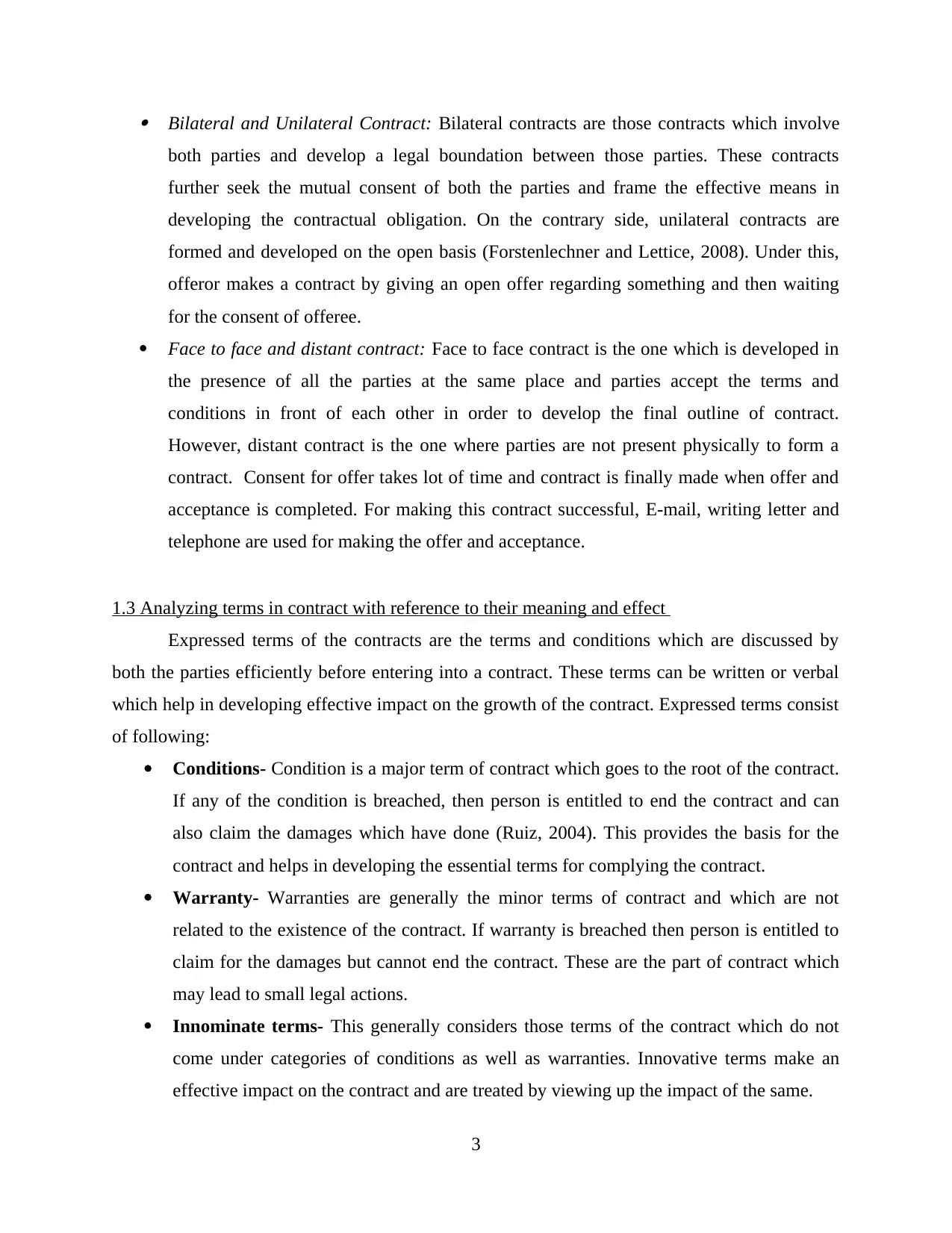
Bilateral and Unilateral Contract: Bilateral contracts are those contracts which involve
both parties and develop a legal boundation between those parties. These contracts
further seek the mutual consent of both the parties and frame the effective means in
developing the contractual obligation. On the contrary side, unilateral contracts are
formed and developed on the open basis (Forstenlechner and Lettice, 2008). Under this,
offeror makes a contract by giving an open offer regarding something and then waiting
for the consent of offeree.
Face to face and distant contract: Face to face contract is the one which is developed in
the presence of all the parties at the same place and parties accept the terms and
conditions in front of each other in order to develop the final outline of contract.
However, distant contract is the one where parties are not present physically to form a
contract. Consent for offer takes lot of time and contract is finally made when offer and
acceptance is completed. For making this contract successful, E-mail, writing letter and
telephone are used for making the offer and acceptance.
1.3 Analyzing terms in contract with reference to their meaning and effect
Expressed terms of the contracts are the terms and conditions which are discussed by
both the parties efficiently before entering into a contract. These terms can be written or verbal
which help in developing effective impact on the growth of the contract. Expressed terms consist
of following:
Conditions- Condition is a major term of contract which goes to the root of the contract.
If any of the condition is breached, then person is entitled to end the contract and can
also claim the damages which have done (Ruiz, 2004). This provides the basis for the
contract and helps in developing the essential terms for complying the contract.
Warranty- Warranties are generally the minor terms of contract and which are not
related to the existence of the contract. If warranty is breached then person is entitled to
claim for the damages but cannot end the contract. These are the part of contract which
may lead to small legal actions.
Innominate terms- This generally considers those terms of the contract which do not
come under categories of conditions as well as warranties. Innovative terms make an
effective impact on the contract and are treated by viewing up the impact of the same.
3
both parties and develop a legal boundation between those parties. These contracts
further seek the mutual consent of both the parties and frame the effective means in
developing the contractual obligation. On the contrary side, unilateral contracts are
formed and developed on the open basis (Forstenlechner and Lettice, 2008). Under this,
offeror makes a contract by giving an open offer regarding something and then waiting
for the consent of offeree.
Face to face and distant contract: Face to face contract is the one which is developed in
the presence of all the parties at the same place and parties accept the terms and
conditions in front of each other in order to develop the final outline of contract.
However, distant contract is the one where parties are not present physically to form a
contract. Consent for offer takes lot of time and contract is finally made when offer and
acceptance is completed. For making this contract successful, E-mail, writing letter and
telephone are used for making the offer and acceptance.
1.3 Analyzing terms in contract with reference to their meaning and effect
Expressed terms of the contracts are the terms and conditions which are discussed by
both the parties efficiently before entering into a contract. These terms can be written or verbal
which help in developing effective impact on the growth of the contract. Expressed terms consist
of following:
Conditions- Condition is a major term of contract which goes to the root of the contract.
If any of the condition is breached, then person is entitled to end the contract and can
also claim the damages which have done (Ruiz, 2004). This provides the basis for the
contract and helps in developing the essential terms for complying the contract.
Warranty- Warranties are generally the minor terms of contract and which are not
related to the existence of the contract. If warranty is breached then person is entitled to
claim for the damages but cannot end the contract. These are the part of contract which
may lead to small legal actions.
Innominate terms- This generally considers those terms of the contract which do not
come under categories of conditions as well as warranties. Innovative terms make an
effective impact on the contract and are treated by viewing up the impact of the same.
3
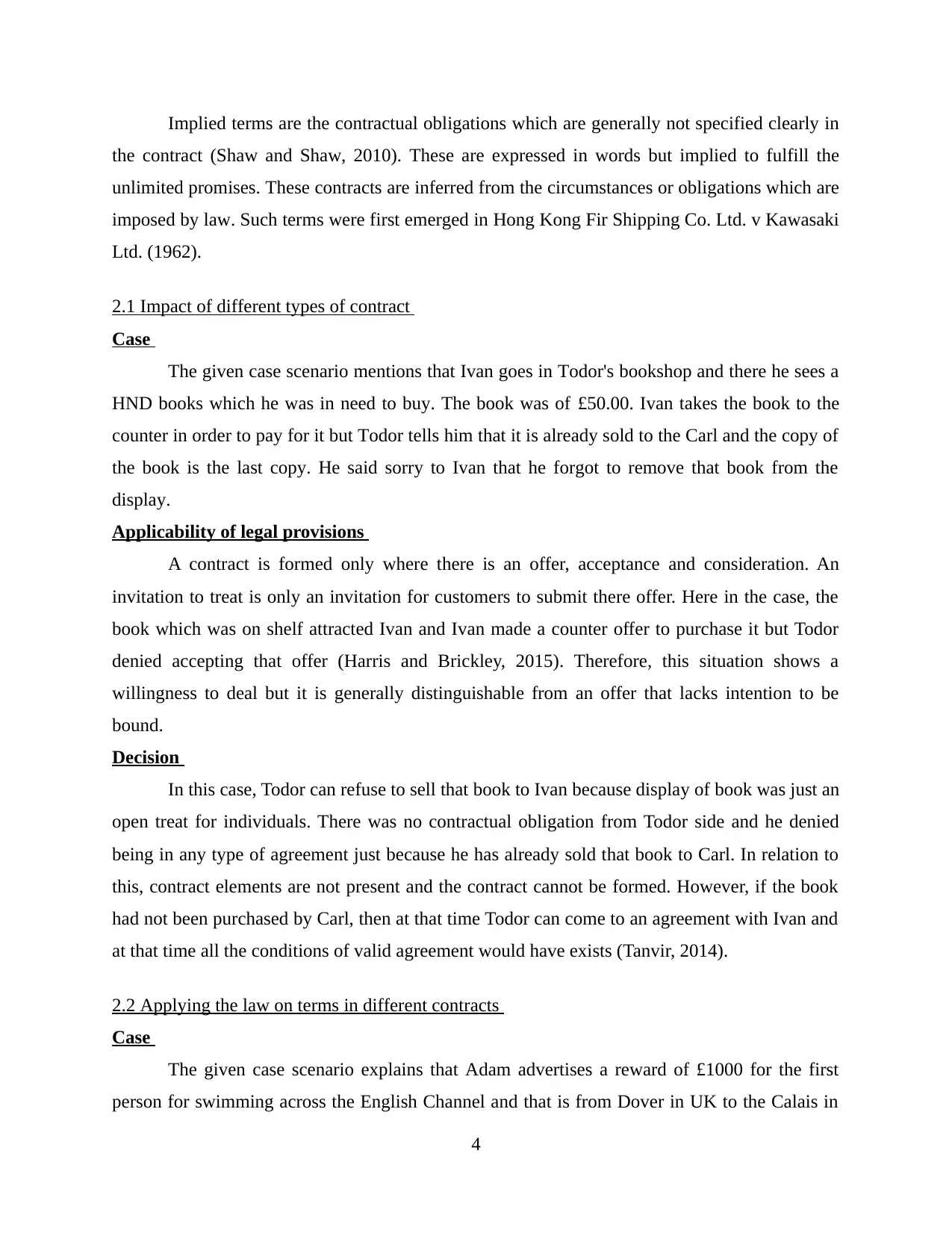
Implied terms are the contractual obligations which are generally not specified clearly in
the contract (Shaw and Shaw, 2010). These are expressed in words but implied to fulfill the
unlimited promises. These contracts are inferred from the circumstances or obligations which are
imposed by law. Such terms were first emerged in Hong Kong Fir Shipping Co. Ltd. v Kawasaki
Ltd. (1962).
2.1 Impact of different types of contract
Case
The given case scenario mentions that Ivan goes in Todor's bookshop and there he sees a
HND books which he was in need to buy. The book was of £50.00. Ivan takes the book to the
counter in order to pay for it but Todor tells him that it is already sold to the Carl and the copy of
the book is the last copy. He said sorry to Ivan that he forgot to remove that book from the
display.
Applicability of legal provisions
A contract is formed only where there is an offer, acceptance and consideration. An
invitation to treat is only an invitation for customers to submit there offer. Here in the case, the
book which was on shelf attracted Ivan and Ivan made a counter offer to purchase it but Todor
denied accepting that offer (Harris and Brickley, 2015). Therefore, this situation shows a
willingness to deal but it is generally distinguishable from an offer that lacks intention to be
bound.
Decision
In this case, Todor can refuse to sell that book to Ivan because display of book was just an
open treat for individuals. There was no contractual obligation from Todor side and he denied
being in any type of agreement just because he has already sold that book to Carl. In relation to
this, contract elements are not present and the contract cannot be formed. However, if the book
had not been purchased by Carl, then at that time Todor can come to an agreement with Ivan and
at that time all the conditions of valid agreement would have exists (Tanvir, 2014).
2.2 Applying the law on terms in different contracts
Case
The given case scenario explains that Adam advertises a reward of £1000 for the first
person for swimming across the English Channel and that is from Dover in UK to the Calais in
4
the contract (Shaw and Shaw, 2010). These are expressed in words but implied to fulfill the
unlimited promises. These contracts are inferred from the circumstances or obligations which are
imposed by law. Such terms were first emerged in Hong Kong Fir Shipping Co. Ltd. v Kawasaki
Ltd. (1962).
2.1 Impact of different types of contract
Case
The given case scenario mentions that Ivan goes in Todor's bookshop and there he sees a
HND books which he was in need to buy. The book was of £50.00. Ivan takes the book to the
counter in order to pay for it but Todor tells him that it is already sold to the Carl and the copy of
the book is the last copy. He said sorry to Ivan that he forgot to remove that book from the
display.
Applicability of legal provisions
A contract is formed only where there is an offer, acceptance and consideration. An
invitation to treat is only an invitation for customers to submit there offer. Here in the case, the
book which was on shelf attracted Ivan and Ivan made a counter offer to purchase it but Todor
denied accepting that offer (Harris and Brickley, 2015). Therefore, this situation shows a
willingness to deal but it is generally distinguishable from an offer that lacks intention to be
bound.
Decision
In this case, Todor can refuse to sell that book to Ivan because display of book was just an
open treat for individuals. There was no contractual obligation from Todor side and he denied
being in any type of agreement just because he has already sold that book to Carl. In relation to
this, contract elements are not present and the contract cannot be formed. However, if the book
had not been purchased by Carl, then at that time Todor can come to an agreement with Ivan and
at that time all the conditions of valid agreement would have exists (Tanvir, 2014).
2.2 Applying the law on terms in different contracts
Case
The given case scenario explains that Adam advertises a reward of £1000 for the first
person for swimming across the English Channel and that is from Dover in UK to the Calais in
4
⊘ This is a preview!⊘
Do you want full access?
Subscribe today to unlock all pages.

Trusted by 1+ million students worldwide
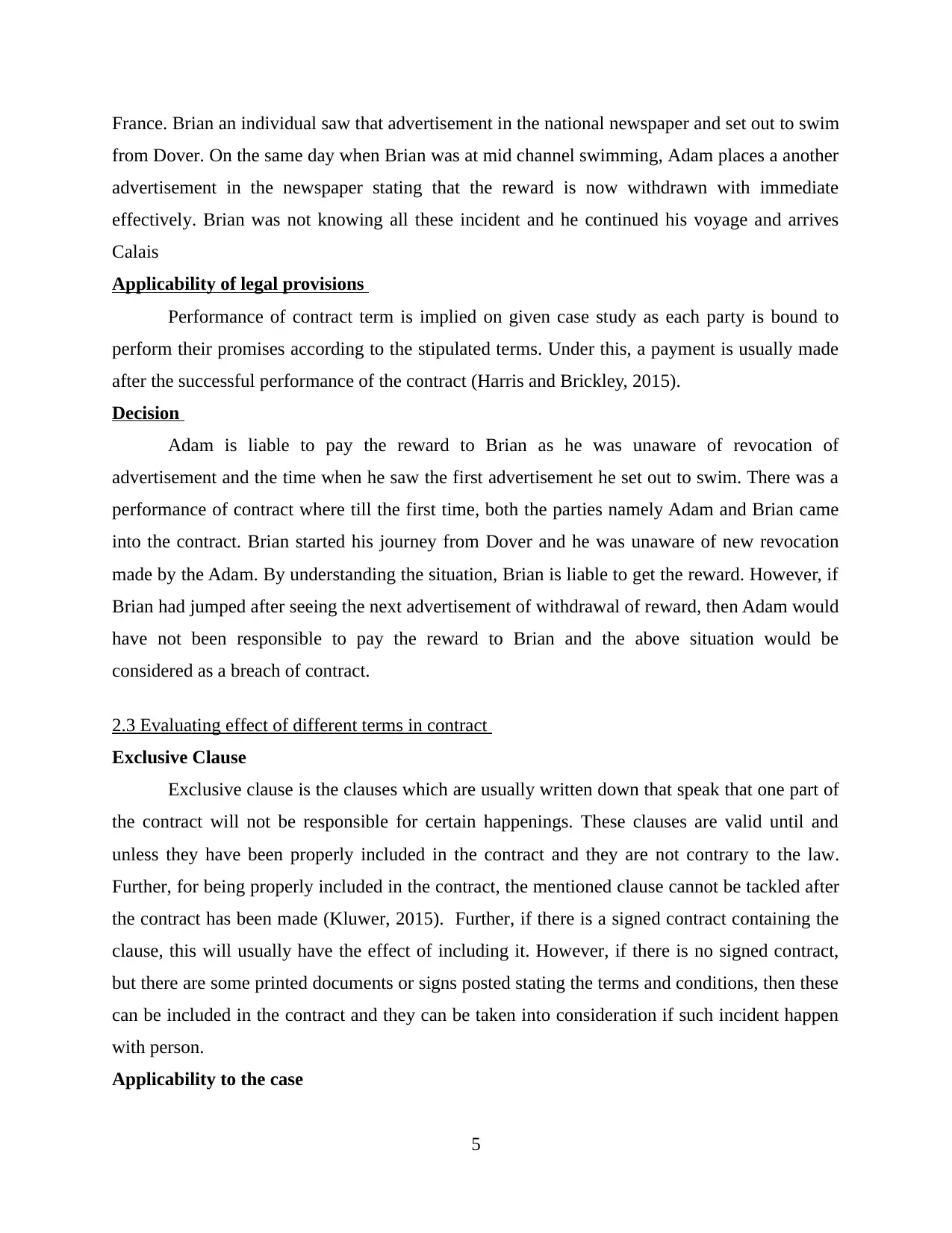
France. Brian an individual saw that advertisement in the national newspaper and set out to swim
from Dover. On the same day when Brian was at mid channel swimming, Adam places a another
advertisement in the newspaper stating that the reward is now withdrawn with immediate
effectively. Brian was not knowing all these incident and he continued his voyage and arrives
Calais
Applicability of legal provisions
Performance of contract term is implied on given case study as each party is bound to
perform their promises according to the stipulated terms. Under this, a payment is usually made
after the successful performance of the contract (Harris and Brickley, 2015).
Decision
Adam is liable to pay the reward to Brian as he was unaware of revocation of
advertisement and the time when he saw the first advertisement he set out to swim. There was a
performance of contract where till the first time, both the parties namely Adam and Brian came
into the contract. Brian started his journey from Dover and he was unaware of new revocation
made by the Adam. By understanding the situation, Brian is liable to get the reward. However, if
Brian had jumped after seeing the next advertisement of withdrawal of reward, then Adam would
have not been responsible to pay the reward to Brian and the above situation would be
considered as a breach of contract.
2.3 Evaluating effect of different terms in contract
Exclusive Clause
Exclusive clause is the clauses which are usually written down that speak that one part of
the contract will not be responsible for certain happenings. These clauses are valid until and
unless they have been properly included in the contract and they are not contrary to the law.
Further, for being properly included in the contract, the mentioned clause cannot be tackled after
the contract has been made (Kluwer, 2015). Further, if there is a signed contract containing the
clause, this will usually have the effect of including it. However, if there is no signed contract,
but there are some printed documents or signs posted stating the terms and conditions, then these
can be included in the contract and they can be taken into consideration if such incident happen
with person.
Applicability to the case
5
from Dover. On the same day when Brian was at mid channel swimming, Adam places a another
advertisement in the newspaper stating that the reward is now withdrawn with immediate
effectively. Brian was not knowing all these incident and he continued his voyage and arrives
Calais
Applicability of legal provisions
Performance of contract term is implied on given case study as each party is bound to
perform their promises according to the stipulated terms. Under this, a payment is usually made
after the successful performance of the contract (Harris and Brickley, 2015).
Decision
Adam is liable to pay the reward to Brian as he was unaware of revocation of
advertisement and the time when he saw the first advertisement he set out to swim. There was a
performance of contract where till the first time, both the parties namely Adam and Brian came
into the contract. Brian started his journey from Dover and he was unaware of new revocation
made by the Adam. By understanding the situation, Brian is liable to get the reward. However, if
Brian had jumped after seeing the next advertisement of withdrawal of reward, then Adam would
have not been responsible to pay the reward to Brian and the above situation would be
considered as a breach of contract.
2.3 Evaluating effect of different terms in contract
Exclusive Clause
Exclusive clause is the clauses which are usually written down that speak that one part of
the contract will not be responsible for certain happenings. These clauses are valid until and
unless they have been properly included in the contract and they are not contrary to the law.
Further, for being properly included in the contract, the mentioned clause cannot be tackled after
the contract has been made (Kluwer, 2015). Further, if there is a signed contract containing the
clause, this will usually have the effect of including it. However, if there is no signed contract,
but there are some printed documents or signs posted stating the terms and conditions, then these
can be included in the contract and they can be taken into consideration if such incident happen
with person.
Applicability to the case
5
Paraphrase This Document
Need a fresh take? Get an instant paraphrase of this document with our AI Paraphraser
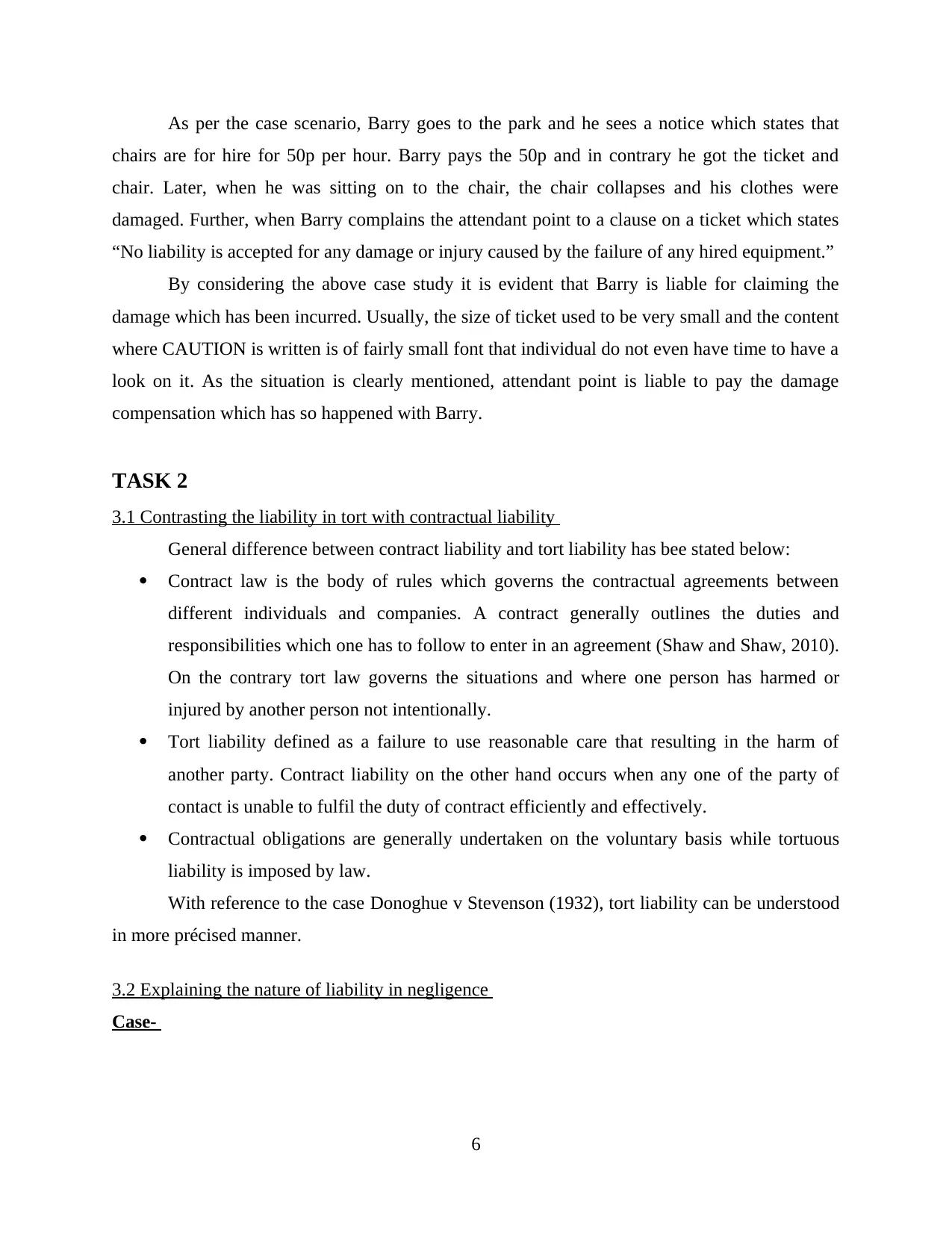
As per the case scenario, Barry goes to the park and he sees a notice which states that
chairs are for hire for 50p per hour. Barry pays the 50p and in contrary he got the ticket and
chair. Later, when he was sitting on to the chair, the chair collapses and his clothes were
damaged. Further, when Barry complains the attendant point to a clause on a ticket which states
“No liability is accepted for any damage or injury caused by the failure of any hired equipment.”
By considering the above case study it is evident that Barry is liable for claiming the
damage which has been incurred. Usually, the size of ticket used to be very small and the content
where CAUTION is written is of fairly small font that individual do not even have time to have a
look on it. As the situation is clearly mentioned, attendant point is liable to pay the damage
compensation which has so happened with Barry.
TASK 2
3.1 Contrasting the liability in tort with contractual liability
General difference between contract liability and tort liability has bee stated below:
Contract law is the body of rules which governs the contractual agreements between
different individuals and companies. A contract generally outlines the duties and
responsibilities which one has to follow to enter in an agreement (Shaw and Shaw, 2010).
On the contrary tort law governs the situations and where one person has harmed or
injured by another person not intentionally.
Tort liability defined as a failure to use reasonable care that resulting in the harm of
another party. Contract liability on the other hand occurs when any one of the party of
contact is unable to fulfil the duty of contract efficiently and effectively.
Contractual obligations are generally undertaken on the voluntary basis while tortuous
liability is imposed by law.
With reference to the case Donoghue v Stevenson (1932), tort liability can be understood
in more précised manner.
3.2 Explaining the nature of liability in negligence
Case-
6
chairs are for hire for 50p per hour. Barry pays the 50p and in contrary he got the ticket and
chair. Later, when he was sitting on to the chair, the chair collapses and his clothes were
damaged. Further, when Barry complains the attendant point to a clause on a ticket which states
“No liability is accepted for any damage or injury caused by the failure of any hired equipment.”
By considering the above case study it is evident that Barry is liable for claiming the
damage which has been incurred. Usually, the size of ticket used to be very small and the content
where CAUTION is written is of fairly small font that individual do not even have time to have a
look on it. As the situation is clearly mentioned, attendant point is liable to pay the damage
compensation which has so happened with Barry.
TASK 2
3.1 Contrasting the liability in tort with contractual liability
General difference between contract liability and tort liability has bee stated below:
Contract law is the body of rules which governs the contractual agreements between
different individuals and companies. A contract generally outlines the duties and
responsibilities which one has to follow to enter in an agreement (Shaw and Shaw, 2010).
On the contrary tort law governs the situations and where one person has harmed or
injured by another person not intentionally.
Tort liability defined as a failure to use reasonable care that resulting in the harm of
another party. Contract liability on the other hand occurs when any one of the party of
contact is unable to fulfil the duty of contract efficiently and effectively.
Contractual obligations are generally undertaken on the voluntary basis while tortuous
liability is imposed by law.
With reference to the case Donoghue v Stevenson (1932), tort liability can be understood
in more précised manner.
3.2 Explaining the nature of liability in negligence
Case-
6
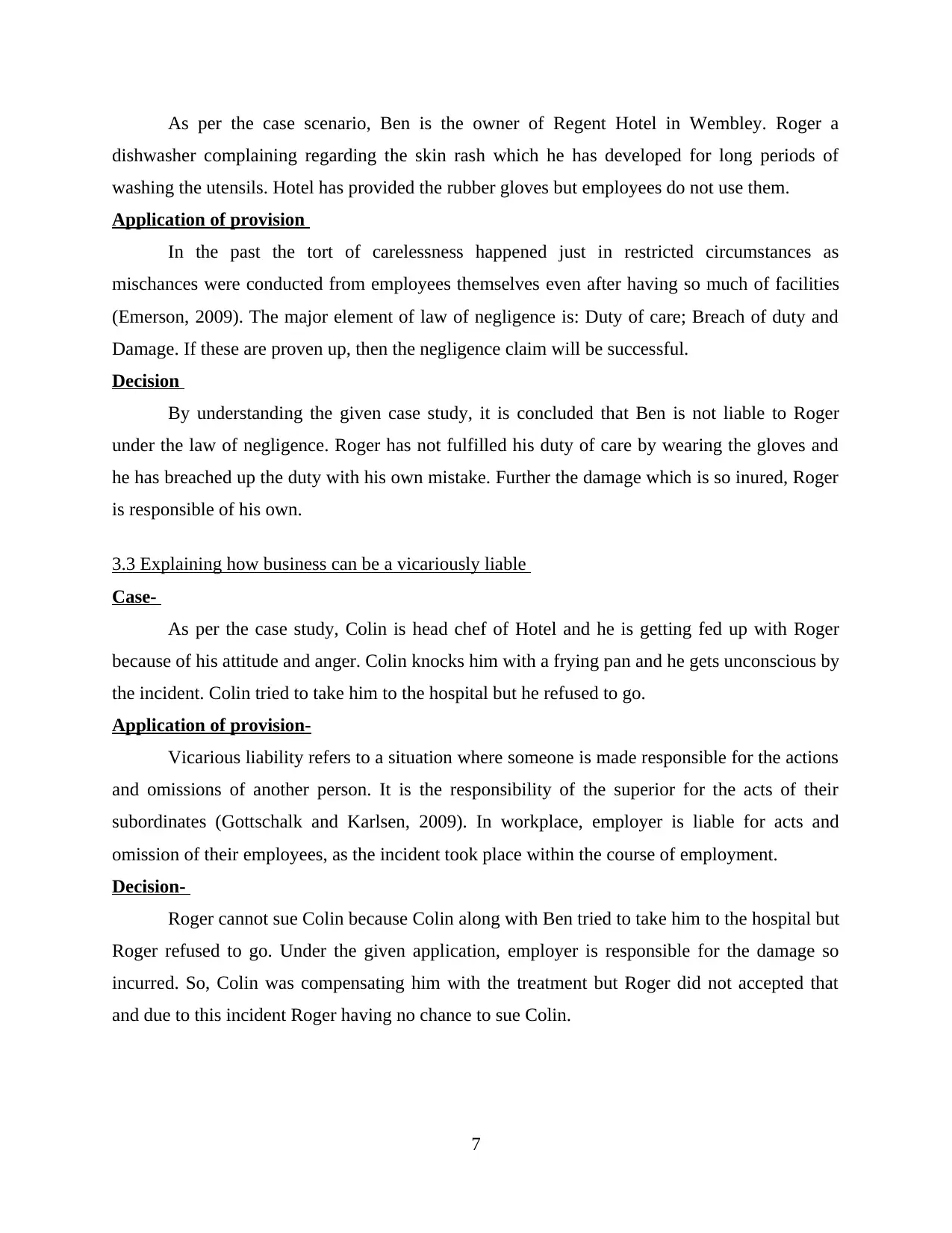
As per the case scenario, Ben is the owner of Regent Hotel in Wembley. Roger a
dishwasher complaining regarding the skin rash which he has developed for long periods of
washing the utensils. Hotel has provided the rubber gloves but employees do not use them.
Application of provision
In the past the tort of carelessness happened just in restricted circumstances as
mischances were conducted from employees themselves even after having so much of facilities
(Emerson, 2009). The major element of law of negligence is: Duty of care; Breach of duty and
Damage. If these are proven up, then the negligence claim will be successful.
Decision
By understanding the given case study, it is concluded that Ben is not liable to Roger
under the law of negligence. Roger has not fulfilled his duty of care by wearing the gloves and
he has breached up the duty with his own mistake. Further the damage which is so inured, Roger
is responsible of his own.
3.3 Explaining how business can be a vicariously liable
Case-
As per the case study, Colin is head chef of Hotel and he is getting fed up with Roger
because of his attitude and anger. Colin knocks him with a frying pan and he gets unconscious by
the incident. Colin tried to take him to the hospital but he refused to go.
Application of provision-
Vicarious liability refers to a situation where someone is made responsible for the actions
and omissions of another person. It is the responsibility of the superior for the acts of their
subordinates (Gottschalk and Karlsen, 2009). In workplace, employer is liable for acts and
omission of their employees, as the incident took place within the course of employment.
Decision-
Roger cannot sue Colin because Colin along with Ben tried to take him to the hospital but
Roger refused to go. Under the given application, employer is responsible for the damage so
incurred. So, Colin was compensating him with the treatment but Roger did not accepted that
and due to this incident Roger having no chance to sue Colin.
7
dishwasher complaining regarding the skin rash which he has developed for long periods of
washing the utensils. Hotel has provided the rubber gloves but employees do not use them.
Application of provision
In the past the tort of carelessness happened just in restricted circumstances as
mischances were conducted from employees themselves even after having so much of facilities
(Emerson, 2009). The major element of law of negligence is: Duty of care; Breach of duty and
Damage. If these are proven up, then the negligence claim will be successful.
Decision
By understanding the given case study, it is concluded that Ben is not liable to Roger
under the law of negligence. Roger has not fulfilled his duty of care by wearing the gloves and
he has breached up the duty with his own mistake. Further the damage which is so inured, Roger
is responsible of his own.
3.3 Explaining how business can be a vicariously liable
Case-
As per the case study, Colin is head chef of Hotel and he is getting fed up with Roger
because of his attitude and anger. Colin knocks him with a frying pan and he gets unconscious by
the incident. Colin tried to take him to the hospital but he refused to go.
Application of provision-
Vicarious liability refers to a situation where someone is made responsible for the actions
and omissions of another person. It is the responsibility of the superior for the acts of their
subordinates (Gottschalk and Karlsen, 2009). In workplace, employer is liable for acts and
omission of their employees, as the incident took place within the course of employment.
Decision-
Roger cannot sue Colin because Colin along with Ben tried to take him to the hospital but
Roger refused to go. Under the given application, employer is responsible for the damage so
incurred. So, Colin was compensating him with the treatment but Roger did not accepted that
and due to this incident Roger having no chance to sue Colin.
7
⊘ This is a preview!⊘
Do you want full access?
Subscribe today to unlock all pages.

Trusted by 1+ million students worldwide
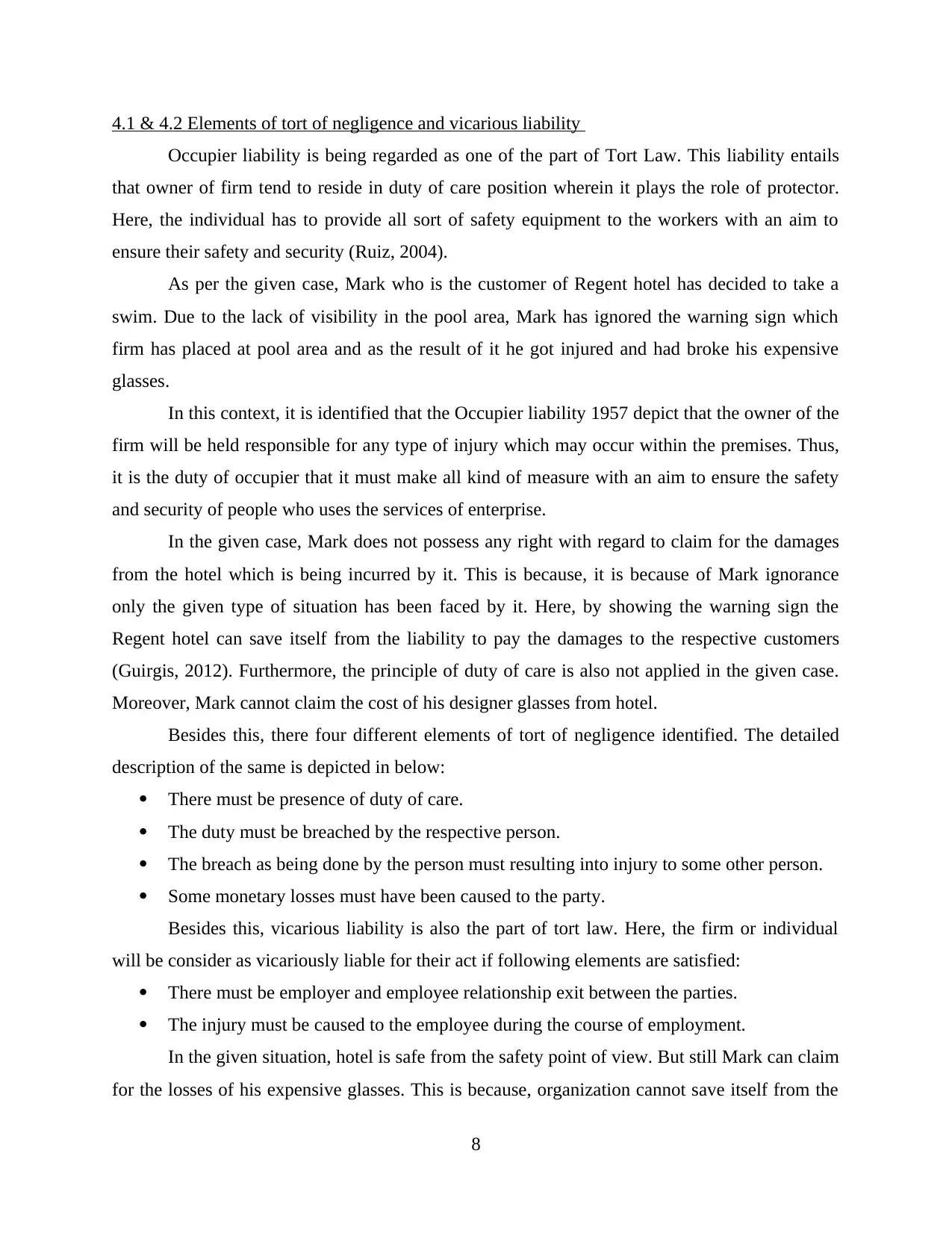
4.1 & 4.2 Elements of tort of negligence and vicarious liability
Occupier liability is being regarded as one of the part of Tort Law. This liability entails
that owner of firm tend to reside in duty of care position wherein it plays the role of protector.
Here, the individual has to provide all sort of safety equipment to the workers with an aim to
ensure their safety and security (Ruiz, 2004).
As per the given case, Mark who is the customer of Regent hotel has decided to take a
swim. Due to the lack of visibility in the pool area, Mark has ignored the warning sign which
firm has placed at pool area and as the result of it he got injured and had broke his expensive
glasses.
In this context, it is identified that the Occupier liability 1957 depict that the owner of the
firm will be held responsible for any type of injury which may occur within the premises. Thus,
it is the duty of occupier that it must make all kind of measure with an aim to ensure the safety
and security of people who uses the services of enterprise.
In the given case, Mark does not possess any right with regard to claim for the damages
from the hotel which is being incurred by it. This is because, it is because of Mark ignorance
only the given type of situation has been faced by it. Here, by showing the warning sign the
Regent hotel can save itself from the liability to pay the damages to the respective customers
(Guirgis, 2012). Furthermore, the principle of duty of care is also not applied in the given case.
Moreover, Mark cannot claim the cost of his designer glasses from hotel.
Besides this, there four different elements of tort of negligence identified. The detailed
description of the same is depicted in below:
There must be presence of duty of care.
The duty must be breached by the respective person.
The breach as being done by the person must resulting into injury to some other person.
Some monetary losses must have been caused to the party.
Besides this, vicarious liability is also the part of tort law. Here, the firm or individual
will be consider as vicariously liable for their act if following elements are satisfied:
There must be employer and employee relationship exit between the parties.
The injury must be caused to the employee during the course of employment.
In the given situation, hotel is safe from the safety point of view. But still Mark can claim
for the losses of his expensive glasses. This is because, organization cannot save itself from the
8
Occupier liability is being regarded as one of the part of Tort Law. This liability entails
that owner of firm tend to reside in duty of care position wherein it plays the role of protector.
Here, the individual has to provide all sort of safety equipment to the workers with an aim to
ensure their safety and security (Ruiz, 2004).
As per the given case, Mark who is the customer of Regent hotel has decided to take a
swim. Due to the lack of visibility in the pool area, Mark has ignored the warning sign which
firm has placed at pool area and as the result of it he got injured and had broke his expensive
glasses.
In this context, it is identified that the Occupier liability 1957 depict that the owner of the
firm will be held responsible for any type of injury which may occur within the premises. Thus,
it is the duty of occupier that it must make all kind of measure with an aim to ensure the safety
and security of people who uses the services of enterprise.
In the given case, Mark does not possess any right with regard to claim for the damages
from the hotel which is being incurred by it. This is because, it is because of Mark ignorance
only the given type of situation has been faced by it. Here, by showing the warning sign the
Regent hotel can save itself from the liability to pay the damages to the respective customers
(Guirgis, 2012). Furthermore, the principle of duty of care is also not applied in the given case.
Moreover, Mark cannot claim the cost of his designer glasses from hotel.
Besides this, there four different elements of tort of negligence identified. The detailed
description of the same is depicted in below:
There must be presence of duty of care.
The duty must be breached by the respective person.
The breach as being done by the person must resulting into injury to some other person.
Some monetary losses must have been caused to the party.
Besides this, vicarious liability is also the part of tort law. Here, the firm or individual
will be consider as vicariously liable for their act if following elements are satisfied:
There must be employer and employee relationship exit between the parties.
The injury must be caused to the employee during the course of employment.
In the given situation, hotel is safe from the safety point of view. But still Mark can claim
for the losses of his expensive glasses. This is because, organization cannot save itself from the
8
Paraphrase This Document
Need a fresh take? Get an instant paraphrase of this document with our AI Paraphraser
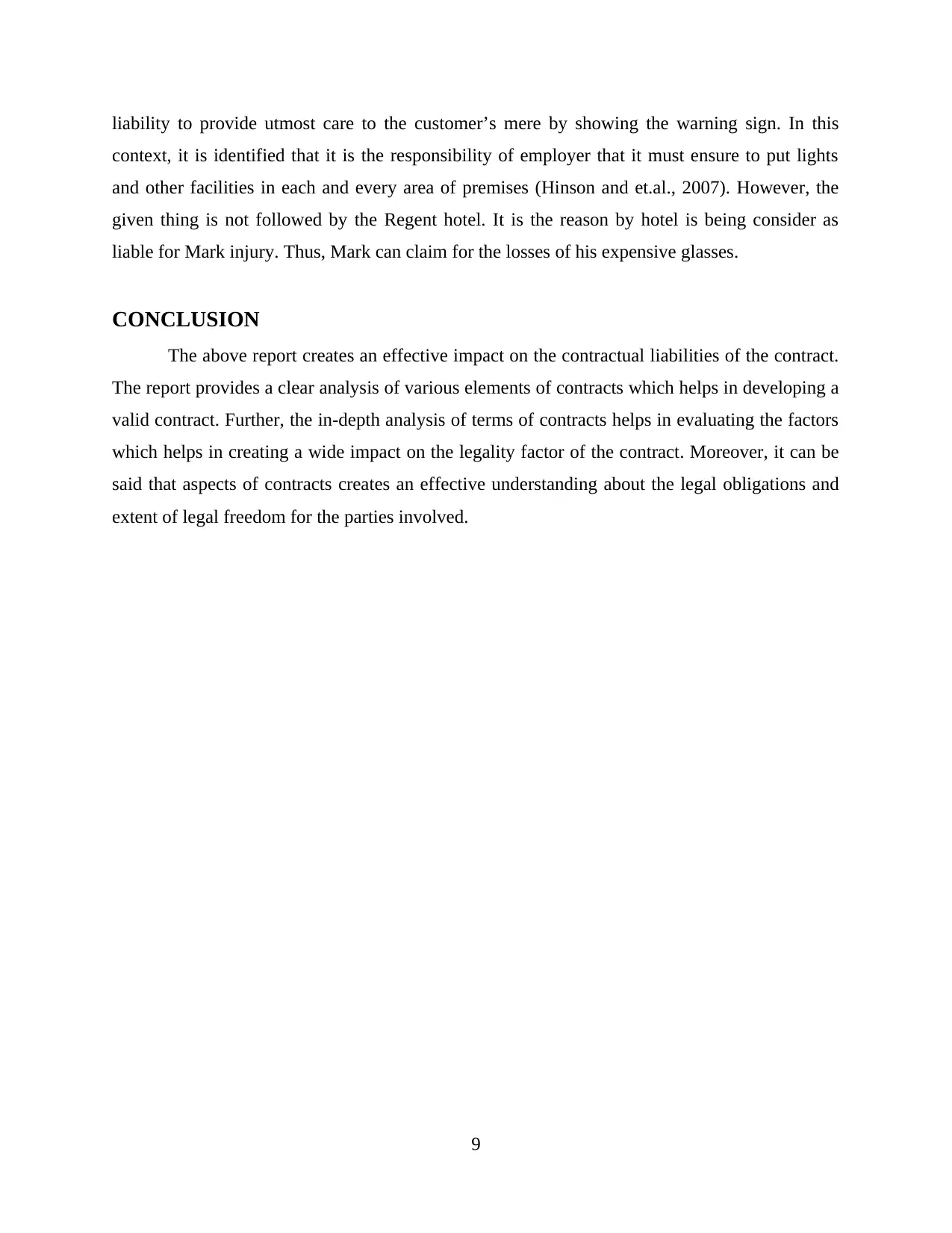
liability to provide utmost care to the customer’s mere by showing the warning sign. In this
context, it is identified that it is the responsibility of employer that it must ensure to put lights
and other facilities in each and every area of premises (Hinson and et.al., 2007). However, the
given thing is not followed by the Regent hotel. It is the reason by hotel is being consider as
liable for Mark injury. Thus, Mark can claim for the losses of his expensive glasses.
CONCLUSION
The above report creates an effective impact on the contractual liabilities of the contract.
The report provides a clear analysis of various elements of contracts which helps in developing a
valid contract. Further, the in-depth analysis of terms of contracts helps in evaluating the factors
which helps in creating a wide impact on the legality factor of the contract. Moreover, it can be
said that aspects of contracts creates an effective understanding about the legal obligations and
extent of legal freedom for the parties involved.
9
context, it is identified that it is the responsibility of employer that it must ensure to put lights
and other facilities in each and every area of premises (Hinson and et.al., 2007). However, the
given thing is not followed by the Regent hotel. It is the reason by hotel is being consider as
liable for Mark injury. Thus, Mark can claim for the losses of his expensive glasses.
CONCLUSION
The above report creates an effective impact on the contractual liabilities of the contract.
The report provides a clear analysis of various elements of contracts which helps in developing a
valid contract. Further, the in-depth analysis of terms of contracts helps in evaluating the factors
which helps in creating a wide impact on the legality factor of the contract. Moreover, it can be
said that aspects of contracts creates an effective understanding about the legal obligations and
extent of legal freedom for the parties involved.
9
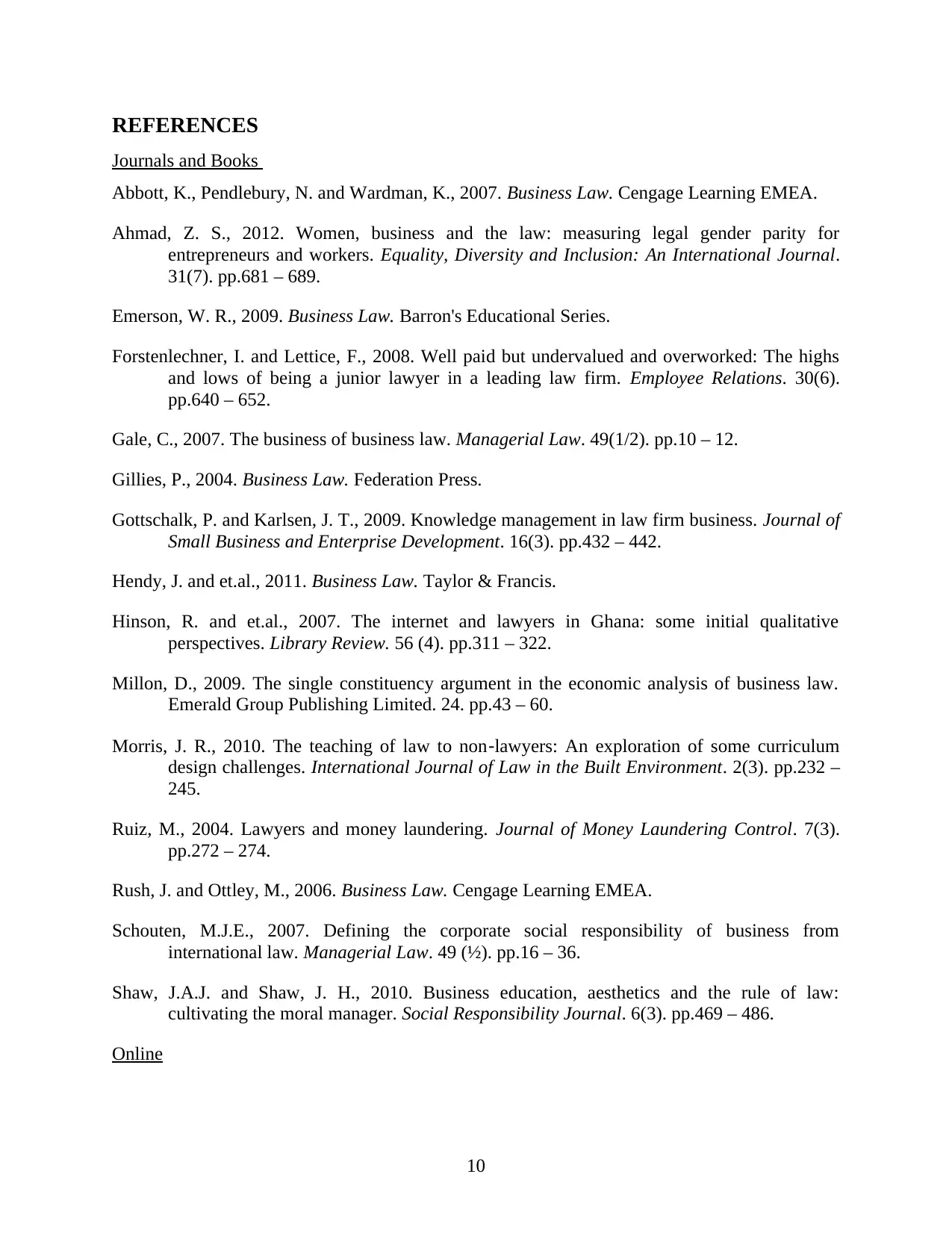
REFERENCES
Journals and Books
Abbott, K., Pendlebury, N. and Wardman, K., 2007. Business Law. Cengage Learning EMEA.
Ahmad, Z. S., 2012. Women, business and the law: measuring legal gender parity for
entrepreneurs and workers. Equality, Diversity and Inclusion: An International Journal.
31(7). pp.681 – 689.
Emerson, W. R., 2009. Business Law. Barron's Educational Series.
Forstenlechner, I. and Lettice, F., 2008. Well paid but undervalued and overworked: The highs
and lows of being a junior lawyer in a leading law firm. Employee Relations. 30(6).
pp.640 – 652.
Gale, C., 2007. The business of business law. Managerial Law. 49(1/2). pp.10 – 12.
Gillies, P., 2004. Business Law. Federation Press.
Gottschalk, P. and Karlsen, J. T., 2009. Knowledge management in law firm business. Journal of
Small Business and Enterprise Development. 16(3). pp.432 – 442.
Hendy, J. and et.al., 2011. Business Law. Taylor & Francis.
Hinson, R. and et.al., 2007. The internet and lawyers in Ghana: some initial qualitative
perspectives. Library Review. 56 (4). pp.311 – 322.
Millon, D., 2009. The single constituency argument in the economic analysis of business law.
Emerald Group Publishing Limited. 24. pp.43 – 60.
Morris, J. R., 2010. The teaching of law to non‐lawyers: An exploration of some curriculum
design challenges. International Journal of Law in the Built Environment. 2(3). pp.232 –
245.
Ruiz, M., 2004. Lawyers and money laundering. Journal of Money Laundering Control. 7(3).
pp.272 – 274.
Rush, J. and Ottley, M., 2006. Business Law. Cengage Learning EMEA.
Schouten, M.J.E., 2007. Defining the corporate social responsibility of business from
international law. Managerial Law. 49 (½). pp.16 – 36.
Shaw, J.A.J. and Shaw, J. H., 2010. Business education, aesthetics and the rule of law:
cultivating the moral manager. Social Responsibility Journal. 6(3). pp.469 – 486.
Online
10
Journals and Books
Abbott, K., Pendlebury, N. and Wardman, K., 2007. Business Law. Cengage Learning EMEA.
Ahmad, Z. S., 2012. Women, business and the law: measuring legal gender parity for
entrepreneurs and workers. Equality, Diversity and Inclusion: An International Journal.
31(7). pp.681 – 689.
Emerson, W. R., 2009. Business Law. Barron's Educational Series.
Forstenlechner, I. and Lettice, F., 2008. Well paid but undervalued and overworked: The highs
and lows of being a junior lawyer in a leading law firm. Employee Relations. 30(6).
pp.640 – 652.
Gale, C., 2007. The business of business law. Managerial Law. 49(1/2). pp.10 – 12.
Gillies, P., 2004. Business Law. Federation Press.
Gottschalk, P. and Karlsen, J. T., 2009. Knowledge management in law firm business. Journal of
Small Business and Enterprise Development. 16(3). pp.432 – 442.
Hendy, J. and et.al., 2011. Business Law. Taylor & Francis.
Hinson, R. and et.al., 2007. The internet and lawyers in Ghana: some initial qualitative
perspectives. Library Review. 56 (4). pp.311 – 322.
Millon, D., 2009. The single constituency argument in the economic analysis of business law.
Emerald Group Publishing Limited. 24. pp.43 – 60.
Morris, J. R., 2010. The teaching of law to non‐lawyers: An exploration of some curriculum
design challenges. International Journal of Law in the Built Environment. 2(3). pp.232 –
245.
Ruiz, M., 2004. Lawyers and money laundering. Journal of Money Laundering Control. 7(3).
pp.272 – 274.
Rush, J. and Ottley, M., 2006. Business Law. Cengage Learning EMEA.
Schouten, M.J.E., 2007. Defining the corporate social responsibility of business from
international law. Managerial Law. 49 (½). pp.16 – 36.
Shaw, J.A.J. and Shaw, J. H., 2010. Business education, aesthetics and the rule of law:
cultivating the moral manager. Social Responsibility Journal. 6(3). pp.469 – 486.
Online
10
⊘ This is a preview!⊘
Do you want full access?
Subscribe today to unlock all pages.

Trusted by 1+ million students worldwide
1 out of 13
Related Documents
Your All-in-One AI-Powered Toolkit for Academic Success.
+13062052269
info@desklib.com
Available 24*7 on WhatsApp / Email
![[object Object]](/_next/static/media/star-bottom.7253800d.svg)
Unlock your academic potential
Copyright © 2020–2025 A2Z Services. All Rights Reserved. Developed and managed by ZUCOL.





